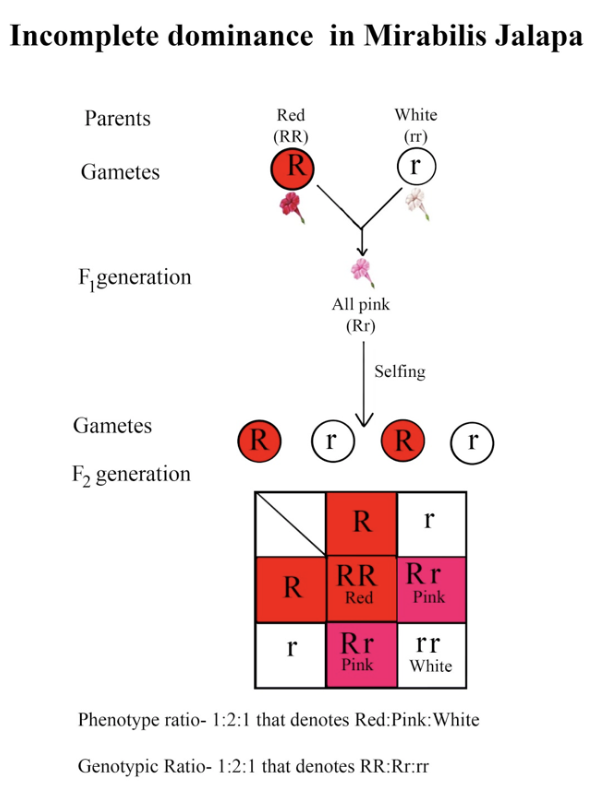
Pink colored flowers are obtained from a cross between a red flower pea plant and white flower pea plant. The appearance of this pink color character is known as
(A) Codominance
(B) Complete dominance
(C) Incomplete dominance
(D) Segregation
Answer
465.6k+ views
Hint: The appearance of a pink-colored flower in the case mentioned in the question is due to a deviation incomplete dominance where the dominant allele i.e. the red color of the flower couldn't suppress the recessive allele i.e. the white color of the flower and an intermediate characteristic appeared.
Complete answer:
Here the appearance of pink-colored flowers in cross-pollination between red and white flower pea plants is an example of incomplete dominance.

The red flower-bearing plant (RR) and the white flower-bearing plant (rr) when cross-pollinated give rise to a pink flower-bearing plant with the phenotype (Rr). It occurs because the dominant allele couldn't completely mask the effect of the recessive allele and the progeny showed a blending of both alleles. This phenomenon is known as incomplete dominance.
Additional Information: In codominance, the alleles of a gene pair are expressed fully in the phenotype, and these alleles that show an independent effect are known as codominant alleles. An example of this phenomenon is ABO blood grouping. The alleles A, B, and O show codominance where O is recessive to both A and B, and A and B are codominant to each other.
In complete dominance, one allele of a gene completely masks the effect of another allele, and the one masking the other is known as dominant and the other is known as a recessive allele. The occurrence of brown and blue eyes is an example of complete dominance. Here brown is always the dominant allele i.e. a person with brown eyes will always have brown eyes but blue is recessive i.e. if a copy of brown eyes is present, the blue eye gene will be completely masked.
According to Mendel's Law of Segregation, between the two gene copies present in an organism only one is sent to each gamete the organism produces and it is randomly allocated.
So, the correct answer is "(C) Incomplete dominance".
Note: Incomplete dominance defies the idea of complete dominance as one allele can not completely dominate the other and the progeny shows a blended character. Gregor Johan Mendel, in his pea plants experiment, studied seven characteristics where he found a similar pattern of inheritance where some of the F1 progeny didn't show any resemblance to the parents but an intermediate progeny.
Complete answer:
Here the appearance of pink-colored flowers in cross-pollination between red and white flower pea plants is an example of incomplete dominance.

The red flower-bearing plant (RR) and the white flower-bearing plant (rr) when cross-pollinated give rise to a pink flower-bearing plant with the phenotype (Rr). It occurs because the dominant allele couldn't completely mask the effect of the recessive allele and the progeny showed a blending of both alleles. This phenomenon is known as incomplete dominance.
Additional Information: In codominance, the alleles of a gene pair are expressed fully in the phenotype, and these alleles that show an independent effect are known as codominant alleles. An example of this phenomenon is ABO blood grouping. The alleles A, B, and O show codominance where O is recessive to both A and B, and A and B are codominant to each other.
In complete dominance, one allele of a gene completely masks the effect of another allele, and the one masking the other is known as dominant and the other is known as a recessive allele. The occurrence of brown and blue eyes is an example of complete dominance. Here brown is always the dominant allele i.e. a person with brown eyes will always have brown eyes but blue is recessive i.e. if a copy of brown eyes is present, the blue eye gene will be completely masked.
According to Mendel's Law of Segregation, between the two gene copies present in an organism only one is sent to each gamete the organism produces and it is randomly allocated.
So, the correct answer is "(C) Incomplete dominance".
Note: Incomplete dominance defies the idea of complete dominance as one allele can not completely dominate the other and the progeny shows a blended character. Gregor Johan Mendel, in his pea plants experiment, studied seven characteristics where he found a similar pattern of inheritance where some of the F1 progeny didn't show any resemblance to the parents but an intermediate progeny.
Recently Updated Pages
Master Class 12 Economics: Engaging Questions & Answers for Success

Master Class 12 Maths: Engaging Questions & Answers for Success

Master Class 12 Biology: Engaging Questions & Answers for Success

Master Class 12 Physics: Engaging Questions & Answers for Success

Master Class 12 Business Studies: Engaging Questions & Answers for Success

Master Class 12 English: Engaging Questions & Answers for Success

Trending doubts
Draw a labelled sketch of the human eye class 12 physics CBSE

The final image formed by a compound microscope is class 12 physics CBSE

Differentiate between homogeneous and heterogeneous class 12 chemistry CBSE

What are the major means of transport Explain each class 12 social science CBSE

Which of the following properties of a proton can change class 12 physics CBSE

What is the energy band gap of silicon and germanium class 12 physics CBSE




